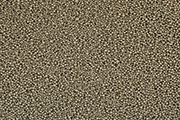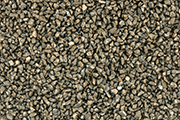E-Archive
Articles
in Vol. 19 - May Issue - Year 2018
Insights into Distinct Cleaning & Peening Media

AMACAST Stainless Steel Shot

AMAGRIT Stainless Steel Grit
Introduction
Shot peening is a well-defined technique. With proper process design, the end expectations of residual compressive stress and depth are clearly identified and parameters to achieve them listed by the designer. The peening intensity, an indicator of the imparted compressive stress, is predicated largely upon the type and size of peening media. In case of steel peening media, the type and size are entities fixed by the designer, with some latitude, at times, given to the end user to choose its hardness. Component drawings specifying shot peening have traditionally stipulated cast steel shot as their choice. With advancement in component design and media technology, it is now common to see the equivalent conditioned cut wire shot specified as an alternative for the process. These are the two ferrous media types used by this industry.
Media preference when blast cleaning or grit blasting a component is subjective. The choice here is reliant on several factors such as durability, surface contamination, surface finish (roughness), carbon contamination, dust generation and economics of use. The topic being vast, the scope of this discussion will be restricted to distinct, ferrous blasting media only. The focus will be to learn more about ferrous media and its potential as a viable and economical alternative to certain non-ferrous media types of lower durability, and address issues related to carbon contamination.
Conditioned Cut Wire Shot
This media type is well-established with the peening community. It is a cold-drawn product (wire), which is then chopped into small cylindrical sections with the length of the cylinder matching the wire diameter. In its cylindrical form, though the sharp edges offer a ‘cutting’ potential such as when cleaning with steel grit, the absence of an operating mix diminishes this possibility. Creation of an operating mix, which is preferred in cleaning, requires the abrasive to breakdown into smaller sized particles. Cut wire does not go through the same breakdown cycle as steel shot and is used for shot peening when conditioned. It’s important to note that in its ‘as cut’ condition it is not recommended for shot peening due to the risk of ‘nicking’ the part with its cylindrical edges and creating localized areas of tensile stress generation and growth.
Conditioning of "as cut" wire to different grades is carried out by bombarding the particles against a flat target, usually a wear-resistant plate strategically positioned inside the blast cabinet. As is already known, repeated exposure to cyclical load results in fatigue or tensile stress in a component. Conditioning of 'ac cut' wire particles results in a similar condition of tensile stress generation. Increase in fatigue reduces durability and transmission of impact energy. Therefore, a prudent practice is for thermal treatment to be carried out on the conditioned material prior to being used as shot peening media. A proprietary thermal treatment process at Ervin re-introduces and re-installs most or all the compressive stress sacrificed during conditioning. This process, carried out in specialized furnaces capable of highly controlled gaseous environments mends grain boundaries that get displaced during conditioning.
The Ervin thermal treatment process also allows to maintain consistent media hardness in the entire batch ensuring transmission of uniform impact energy to all areas of the component. CW shot when used in a peening machine doesn’t break down but eventually wears to a smaller size ultimately to be discarded by the size classifier. Given the benefit of this thermal treatment process, research is ongoing to demonstrate whether the discarded, smaller sized cut wire could be thermally treated for a second time to recover and re-impart all its lost energy. This presents the possibility of potentially re-employing the media in a peening process requiring smaller sized media.
Use of Stainless Steel Media
Stainless steel media manufactured by Ervin is available in three versions – Stainless steel shot (AMACAST), Stainless steel grit (AMAGRIT) and Ferritic Stainless steel shot (AMACHROME). Each of the above has a defined spot in peening and cleaning applications.
AMACAST stainless shot has a unique work-hardening property, where it starts at a typical hardness of 200 HV (93 Rockwell B) and with repeated impact, work-hardens to about 530 HV (51 Rockwell C), increasing the life-cycle to about 5000 impacts. In practical terms, this means that the media will maintain its shape and size in the machine for a longer duration and continue to transfer energy with uniformity without disintegration. Due to its spherical shape, it’s also an established media for shot peening components where carbon contamination poses an issue.
With the use of carbon steel media, the possibility of material transfer from media to the component though minimal, still exists. Also, when peening non-magnetic components with carbon steel shot/grit, there is an added concern of magnetizing it with the media. The 16-20% Chromium and 6-10% Nickel in AMACAST 300-series media minimize contamination and corrosion potential. In both cases, the material transfer potential is partly dependent on the metallurgy of the component being blasted (or peened). A component with high manganese content will resist magnetization caused by change in state during blasting. In general, the change in state from austenite to martensite (which is magnetic) in the component will magnetize it much before the media can do so with its chemistry.
Use of Stainless Steel Grit
An example of angular media in the stainless steel sector is AMAGRIT, a contaminant-free inert stainless steel grit. With approximately 30% chromium and hardness of about 57 HRc, this media shows no trace of rust even after a 24-hour salt spray test. Therefore, the applications for this media are several, and it carries the potential to replace Aluminum Oxide, Glass Bead and Garnet due to some distinct advantages. An example of one such application is to blast tractor trailers used to transport new automobiles. Such trailers are required to be blasted with a contaminant free media to minimize the risk of carbon media residue that could potentially rust and transfer it to the new autos being transported. The common non-ferrous choice is Aluminum Oxide. With a minimum of two operators blasting simultaneously (about 20 lbs/min), the dust generated due to rapid media breakdown of aluminum oxide (6-8%) and loss of productivity due to poor visibility inside the airblast room are significant issues. In such a situation, stainless steel grit offers a viable alternative.
Stainless grit enjoys durability that’s atleast 50 to 75 times that of AlOx, given the same process parameters. This translates into lower dust generation and disposal costs. The atmosphere inside the airblast room is less-cloudy resulting in increased productivity levels. The operating cost with stainless grit is lower not only due to its lower attrition, but also given the decreased frequency at which blast nozzles, hoses and blast tank parts need to be replaced. Users have reported about 85% savings in such consumable costs. This can be seen at https://www.youtube.com/watch?v=VXvcC9MCiJE. Stainless grit is also popular for contaminant-free cleaning of aluminum castings, stainless forgings, zinc pressure die-castings, corrosion-prone metal surfaces and stainless railroad cars. Dust disposal efforts and costs are quite significant when blasting with low-durability media such as AlOx. Certain municipalities, local and state agencies offer incentives to factories to minimize waste generation and reduce content being sent to landfills. This is something that will certainly add to the justification of using blast media of greater durability.
Cleaning is just one aspect of stainless steel grit usage. Certain critical components in the Aerospace industry rely on aluminum oxide grit to prepare their surfaces prior to a downstream coating process. Blasting with aluminum oxide helps produce a component with required values of surface roughness. Aerospace specifications are stringent and rely on several inputs including media integrity to maintain consistent surface finish. Though the quality is controlled and kept in check using a vibratory classifier, use of stainless steel grit has the potential to maintain shape and size integrity for a much longer duration than aluminum oxide or any non-ferrous media. Whether in a manual or automated operation, stainless steel grit is a more durable choice than non-ferrous media.
At a slightly lower chromium content (18%), AMACHROME offers yet another choice of stainless shot. Though not as circular as AMACAST discussed earlier, AMACHROME is widely used for cleaning automotive components. The use of this media over other stainless variants is mainly user-dependent since both offer similar properties, with the stainless shot providing a more spherical shape resulting in a corresponding surface profile. Unlike AMACAST stainless shot that work hardens, AMACHROME has a stable hardness and well-suited for lower impact cleaning especially in components without any tenacious scale or other such contaminant requiring cleaning.
Media choice and machine design
Shot peening: The goal of shot peening is the generation of residual compressive stress with accuracy, repeatability and consistency. The user is very rarely given the choice of media type to use. Regardless, it is critical that proper maintenance procedures are in place to maintain media quality. The obvious ones are the classifier (for size control), spiral separator (for shape control), and flow control valves to monitor and control media flow rate (maintaining a constant media flow rate is very critical in repeatable peening results). Regular visual media inspection should be part of the maintenance procedure. Saturation curves will reveal the health of the process and they should be plotted with diligence. Though a time-consuming task, this step should never be bypassed and carried out at defined intervals (end of shift, batch or as stipulated in process specifications).
Grit Blasting: Grit blasting with the intention of repeatability and accuracy of results requires equipment that is very similar to shot peening in terms of process control. At the very basic level, the effectiveness of the process is judged by DFT (dry film thickness) of the layer that will be painted downstream to grit blasting. In more sophisticated applications, the thickness and adherence strength of a metalized layer on the blasted component determine the effectiveness of the grit blasting process. The former, if done improperly, could result in the premature failure of the component, and in certain cases lead to catastrophic results. Similarly, an uneven metalized layer thickness could result in non-uniform heat transfer in an aircraft engine, the repercussions of which could be critical. Given the overall impact to the environment, worker productivity, durability, operating and trailing costs, ferrous grit blasting media show technical prominence over the non-ferrous types. Critical operations are often specifications driven and not easy to change, especially those with a long history. As a general thought, it can't be denied that technology has evolved, and it is critical to explore, identify and validate use of better materials and processes to improve overall efficiency in the surface finishing industry.
For Information:
Ervin Industries
3893 Research Park Dr
Ann Arbor, MI 48108, USA
Tel. +1.734.769-4600
E-mail: sales@ervinindustries.com
www.ervinindustries.com



























